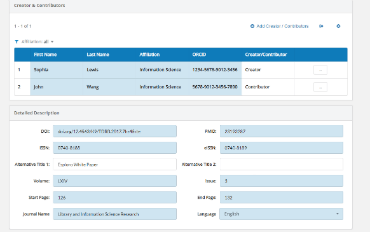However, as technology, research workflows, and scholarly needs are evolving rapidly, the collection of research outputs and data must keep pace to remain valuable. The library – with its recognized expertise in handling collections - may be the right place to start addressing this challenge. Ex Libris Esploro does that, and more, with a next-generation research repository that is cloud-based, centralized, comprehensive and easy-to-use.

The Value of Institutional Repositories and Their Weaknesses
Institutional repositories, usually managed by a university’s library, are where the research work of faculty members can be collected and collated for future reference and dissemination. Researchers and the broader academic community, as well as the general public in some cases, can benefit from the research of others.
A repository makes it easier to fulfill one of the core missions of any serious researcher and every research university – to share knowledge gained and discoveries made. With access to an up-to-date, comprehensive research repository, valuable information on experiment results, gathered data, and specialist analysis can all be found, used and built upon.
A centralized collection of research outputs and auditable records of their use make it easier to demonstrate the impact of such research to institutional decision-makers. They similarly help universities comply with regulations requiring the publication of research funded with public taxes.
As valuable as repositories have been, today they are failing to effectively meet the needs of researchers, libraries and their institutions. A growing complexity among research funding and grant opportunities, more robust compliance rules, new institutional demands, and dynamic technological advances are contributing to this situation. As institutions of higher education find themselves under increasing pressure, they are potentially risking their ability to maintain or improve their academic reputation.
Universities therefore need a new approach to storing and managing their research assets. Esploro’s centralized, comprehensive, easy-to-use, and cloud-based next-generation research repository makes it much easier to collect, manage and promote a university’s research output, as well as to track its real-world impact; not least of all because the research is easily and comprehensibly discoverable.
How do most repositories currently in use differ from the next-generation Esploro alternative and what are the effects of this gap?

On Patchwork Structures and Disparate Systems
Institutional repositories are often an incomplete collection of materials, inconsistently updated, difficult to maintain and use, and with different workflows for depositing new research, data sets, and metadata.
In some cases, a single institution will have multiple partial repositories, with their own quirks of development and processes, for different kinds of materials. This can be because of repositories designed to handle only specific types of assets (publications, data sets, clinical data, unpublished research, etc.) or because of systems added separately over time for different resource types or fields of research.
In other cases, even an institution with a single central repository can find itself with an undifferentiated or poorly organized collection of content, due to a research asset management strategy that is lacking or absent entirely. To find any value in such a repository, a researcher searching for relevant outputs has to engage in slow, manual sifting – and even then, the results are often incomplete.
Whether a patchwork of disparate systems or a mixed bag, such repositories make it challenging to link data and publications, to standardize the collection of research assets, and to consistently apply metadata to these assets. The discoverability of research done at the university is thus far from what it should be, causing both the institution and the original researcher to lose opportunities to fully showcase their contributions to the field – or at times to even know what they are.
How can the systemic and structural problems of most current research repositories be overcome?
Managers of research repositories should strive for comprehensiveness of asset types and connectedness throughout research information management. With Esploro, for example, a single repository is used to collect, manage, and showcase all research faculty output and data types across a full range of academic disciplines.


Automation and Changing Behaviors
Another of the challenges in maintaining a useful institutional research repository is motivating faculty researchers to deposit their outputs and data, and to do so consistently.
Generally, populating an institutional repository is accomplished by researchers filling out an online form. This takes time, patience, and an understanding of its value. Unfortunately, many faculty members do not have one or all of these things and infrequently follow through on that step in their research process. Moreover, in most cases, the deposit process is so cumbersome it is largely ignored even by those researchers who would otherwise want to add their material to the repository.
Even if faculty faithfully deposit their research output in an institutional repository, they often do so with incomplete metadata or with none at all. For the uploaded material to be discoverable, library staff must add or enrich the metadata associated with these entries manually. This can consume a significant amount of time and sometimes requires a back-and-forth with the faculty member to sufficiently understand the material.
What is an effective way to ensure research outputs, data, metadata and related materials are actually deposited in a repository?
The next-generation Esploro research repository accomplishes that with extensive automated processes, making the capture and deposit of research assets consistent, coherent, and methodically accurate wherever possible.

The Challenges of Change and Scale
Without an institutional long-term strategy for storing and managing research assets, a university can find its repository unprepared to adapt to changes in technology for capturing or creating assets. Without flexible technology to meet these strategic needs, as one research article notes, the result is often the creation of multiple repositories within the same institution and across the same disciplines.
Another challenge of adaptability for the research repository is scalability. This arises when an institution grows in size or expands to include new fields of research, while the processes and protocols for deposit, management and storage were perhaps appropriate for a smaller institution, but can no longer efficiently handle the increasing workflow. In other cases, the goals for the institutional repository may have evolved over time, while the processes have not been revised accordingly. A related issue, common in many organizations, is tribal knowledge lost to the university when a repository manager leaves.
On the other hand, a repository requires consistency and predictability for discoverability and ease of use. How can this tension be resolved?
Esploro leverages could-based technology to ensure every research repository is able to grow with the institution.


The Role of the Library
Library support for academic research is largely focused on the publication side, such as managing article processing charges, finding relevant journals for publication, deposits to institutional repositories, and ensuring compliance with Open Access policies. This is confirmed by a study commissioned by Ex Libris to assess the experience of researchers and senior members of university research offices in conducting, and supporting the production of, research at institutions of higher education.
Alterline, the independent research agency that conducted the study, identified several notable results related to the relationship between institutional research repositories and academic libraries. For example, when asked about which research management systems were used at their institution, senior members of university research offices did not usually reference those related to content, publications and data repositories. Analysts assess that this may be due to a perception that such activities are strictly under the library’s purview.
In what other ways do libraries play a role in research asset management in the context of institutional repositories?
Additional findings, based on data from the United Kingdom, the United States, and Australia gathered in 2019, include:
- 45% of researchers deposit to an institutional repository independently.
- 39% sometimes do so with assistance.
- 16% say that someone else always does it for them.
For more details, read the full Ex Libris study here.


